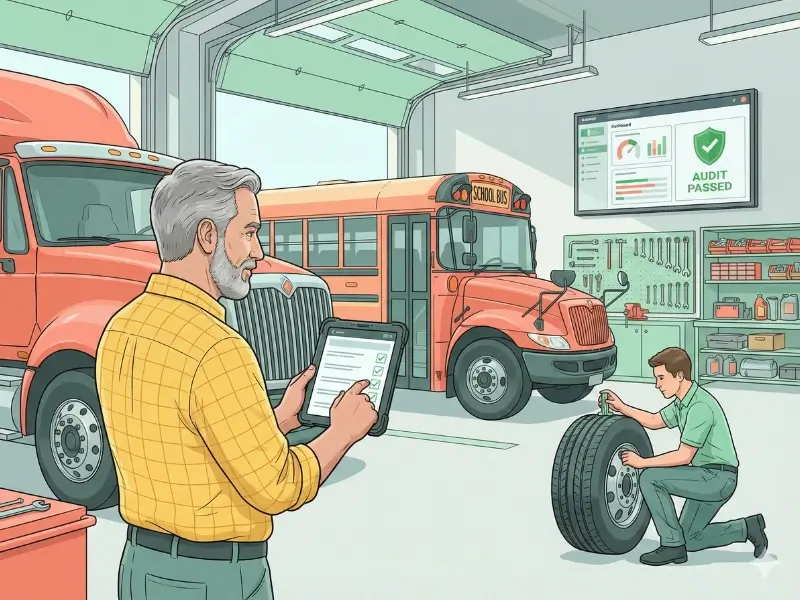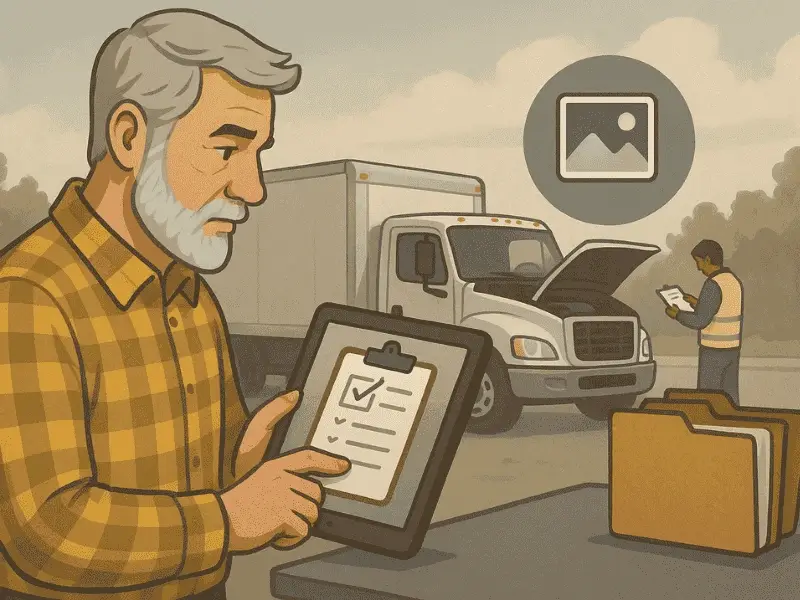Key Takeaways
- Spill protection
- Fire control systems
- Emergency shutoffs
- Warning signs and placards
- A Hazmat CDL
- Knowledge of safety rules
- Clean driving history
- Plan safe routes (no tunnels or crowded areas)
- Check trucks before and after trips
- Secure cargo so it doesn’t move or spill
- Watch truck sensors during the trip
Transporting hazardous materials, often called hazmat, is one of the most critical and challenging aspects of fleet management. These materials include anything from flammable liquids and toxic chemicals to radioactive substances and corrosive acids.
Hazmat trucking plays a vital role in supporting everyday life, delivering fuels, industrial chemicals, medical supplies, and more. However, because of the risks involved, hazmat trucking demands careful planning, strict regulatory compliance, specialized equipment, and trained personnel.
If you manage a fleet that handles hazmat loads or are considering expanding into this space, this guide covers everything you need to know, from understanding hazmat classifications and truck types to ensuring driver qualifications and leveraging technology to improve safety and operational efficiency.
What Exactly Is Hazmat Trucking?
Hazmat trucking involves the transportation of hazardous materials that can potentially harm people, property, or the environment if mishandled. The U.S. Department of Transportation (DOT) classifies hazardous materials into nine broad categories, each with its own safety and handling protocols:
- Class 1: Explosives (e.g., dynamite, fireworks)
- Class 2: Gases (flammable, non-flammable, toxic gases like propane or chlorine)
- Class 3: Flammable Liquids (gasoline, ethanol, solvents)
- Class 4: Flammable Solids (matchsticks, spontaneously combustible materials)
- Class 5: Oxidizers & Organic Peroxides (hydrogen peroxide, ammonium nitrate)
- Class 6: Toxic & Infectious Substances (pesticides, medical waste)
- Class 7: Radioactive Materials (uranium, medical isotopes)
- Class 8: Corrosives (battery acid, caustic soda)
- Class 9: Miscellaneous Hazards (dry ice, lithium batteries)
Each class has strict rules on packaging, labeling, placarding, and transportation to reduce risk during transit. As a fleet manager, knowing these classifications is the foundation of safe and compliant hazmat operations.
Matching the Right Truck to the Cargo
Hazmat cargo isn’t one-size-fits-all, and neither are the trucks. Different hazardous materials require different vehicle designs and safety features:
- Tank Trucks: Used for liquids and gases such as gasoline, acids, or propane. These trucks have cylindrical, often double-walled tanks made of corrosion-resistant materials, with pressure control and spill containment features.
- Box Trucks: Ideal for small, packaged hazardous goods like toxic chemicals or medical waste. They have reinforced cargo areas to prevent leaks or spills.
- Flatbed Trucks: Used for oversized or bulky items, usually secured in sealed containers. Proper tie-downs and protective covers ensure the cargo stays stable and secure.
- Vacuum Trucks: Equipped with pumps to collect and transport hazardous liquid waste, useful in spill cleanups or waste removal.
- Refrigerated and Cryogenic Tankers: These maintain temperature control for perishable chemicals or liquefied gases like liquid nitrogen, using insulation and active cooling systems.
- Dry Bulk Trucks: Designed for solid hazardous materials like powders or granules, featuring pneumatic unloading systems for easy handling.
- Corrosive Tankers: Built with specialized liners to safely transport strong acids and alkalis.
Download our free Tow Truck Pre-Trip Inspection Checklist
Essential Safety Features for Hazmat Trucks
Because of the nature of the cargo, hazmat trucks include features beyond standard commercial vehicles:
- Reinforced Construction: Using materials like stainless steel or aluminum to resist corrosion, pressure changes, and extreme temperatures.
- Spill Containment: Double walls or secondary containment trays that prevent hazardous leaks in case of tank failure.
- Pressure and Ventilation Systems: Relief valves and vents help manage gas pressure and prevent dangerous buildups.
- Emergency Shutoff Valves: These can be triggered manually or automatically to stop leaks during accidents or malfunctions.
- Placarding and Labeling: Trucks must display clear hazard placards on all sides indicating the material class and UN identification number to inform first responders during emergencies.
- Fire Suppression Systems: Built-in extinguishers or foam systems to quickly address fires involving flammable or chemical cargo.
- Anti-Rollover and Stability Controls: Electronic stability control and advanced braking systems reduce accident risks, especially given the heavier and sometimes volatile loads.
- GPS and Monitoring Technology: Real-time tracking combined with sensors that monitor internal tank conditions (temperature, pressure) improve oversight and safety.
The Human Element: Qualified Hazmat Drivers
Your trucks are only as safe as the people who drive them. Hazmat drivers must meet stringent requirements:
- Commercial Driver’s License (CDL) with Hazmat Endorsement: Drivers must pass a written test focused on hazmat rules and regulations, undergo a Transportation Security Administration (TSA) background check, and meet physical standards set by the Department of Transportation (DOT).
- Tanker Endorsement (if applicable): Needed for transporting liquid cargo in tank vehicles.
- Specialized Training: Ongoing education on proper loading, unloading, handling of materials, and emergency procedures is essential. Refresher courses keep drivers up to date with regulation changes.
- Clean Driving Record: Given the risks, companies seek drivers with minimal violations or accidents.
- Emergency Preparedness: Drivers must know how to use personal protective equipment (PPE), spill kits, and fire suppression tools, and be able to execute emergency response plans.
Operational Best Practices for Hazmat Fleets
Managing hazmat trucking operations demands a disciplined approach:
- Route Planning: Avoid restricted zones like tunnels, bridges, and densely populated areas to minimize risk exposure and comply with local regulations.
- Pre-Trip Inspections: Thorough vehicle and equipment checks are mandatory before every run. Drivers verify placards, safety gear, tires, brakes, and containment systems.
- Cargo Securement: Properly distribute weight and securely fasten cargo to prevent shifting or spills during transit.
- Continuous Monitoring: Drivers should monitor cargo conditions regularly and use telematics data to detect irregularities in real-time.
- Scheduled Stops: Frequent inspections during trips help identify and address issues before they escalate.
- Clear Emergency Protocols: Drivers need easy access to emergency contact numbers, response plans, and on-board safety equipment.
- Post-Trip Procedures: Decontamination and cleaning of vehicles, inspection for damage, and detailed record-keeping complete the transport cycle.
Building a Safety-First Culture
Technology and regulations set the framework, but culture drives consistent safety:
- Continuous Training and Mentorship: Pair experienced hazmat drivers with newcomers. Promote open communication to share lessons learned and best practices.
- Standard Operating Procedures (SOPs): Develop clear, written checklists for inspections, loading, unloading, and emergencies. Make them easy to access and follow.
- Regular Safety Audits: Use internal and third-party reviews to spot gaps and improve processes continuously.
- Reward Safe Behavior: Recognize drivers and teams who demonstrate exemplary safety performance.
Boost Compliance and Safety with Simply Fleet
Hazmat trucking demands dedication, expertise, and attention to detail but the rewards are significant. With the right vehicles, qualified drivers, clear procedures, and modern fleet management technology, you can reduce risk, improve operational efficiency, and open doors to premium markets.
Ready to improve your hazmat trucking operation? Start by reviewing your fleet’s compliance, investing in driver training, and adopting fleet management tools designed to keep your drivers and communities safe. The road ahead is challenging but with the right approach, it’s also full of opportunity.



.png)








.png)


.png)




.webp)



